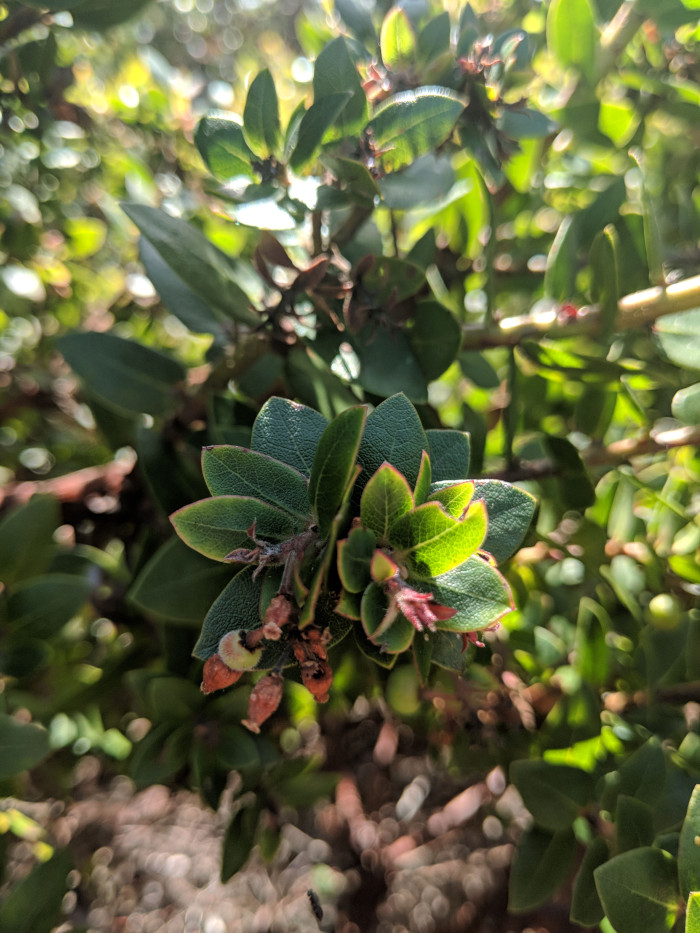Pajaro Manzanita
Arctostaphylos pajaroensis
 Photo: Joe Broberg
Photo: Joe Broberg
Introduction
Status
Ecological Requirements
RCIS Regions: Pajaro River, Gabilan Range and Pinnacles National Monument, Monterey Bay Coastline, Outer Coast Range, Inner Coast Range, Salinas Valley (CDFW 2020)
RCIS Natural Communities: Mixed Chaparral (CDFW 2020; CNPS 2019b)
Fire-adapted found in sandy soils at edges and openings of chaparral (CDFW 2020; CNPS 2019b)
Full species account available: Arctostaphylos Pajaroensis Fact Sheet (Coastal Training Program 2020b)
RCIS Conservation Target: High (non-listed, limited range, represents near-endemic to RCIS area, unique habitat [sandy chaparral])
Associated Non-Focal Species
Range and Modeled Habitat
Climate Change Vulnerability Assessment
Conservation Strategies
Pajaro Manzanita Goals, Objectives, and Actions
There are 21 proposed actions. For complete goals, objectives and actions explanations see the complete table of conservation strategies in the RCIS PDF.
Species Goals, Objectives, and Actions
Goal PM 1
Promote persistence of Pajaro manzanita populations in the RCIS area through protection, restoration, and enhancement of habitat.Objective PM 1.2
Enhance occupied and suitable Pajaro manzanita habitat. Measure progress towards achieving this objective by acres of habitat and adjacent/equivalent acres enhanced and occupied by Pajaro manzanita.Action PM 1.2.1
Use prescribed burns to promote plant establishment in coordination with scientific advisors, land managers, universities, and/or regulatory agencies to inform the location and frequency of potential burn areas.
Regional Goals, Objectives, and Actions
Goal RC 1
Sustain resilient, connected natural communities for the full range of native species, habitats, and ecological functions in the RCIS area through the protection of large blocks of continuous habitat supporting sensitive species.Objective RC 1.1
Protect and preserve existing intact non-marine habitats and resources and allow for expansion of habitat by protecting suitable or occupied habitat. Measure progress towards achieving this objective by the number of acres of habitat and adjacent/associated acres protected.Action RC 1.1.1
Acquire parcels with suitable habitat through fee title purchase or conservation easement.
Action RC 1.1.2
Conduct surveys using eDNA and/or traditional survey methods in suitable or potentially suitable habitat to locate undocumented occurrences of focal species and other conservation elements and opportunities for habitat protection, enhancement, restoration, and creation (USFWS 2008).
Action RC 1.1.3
Create and sustain long-term funding for protected areas maintenance.
Action RC 1.1.4
Establish an incentive program for private landowners to protect occurrences and manage habitat.
Action RC 1.1.5
Protect populations from impacts from construction, vegetation management, and/or activities, including by surveying areas such as roads/trails and implementing species protection measures.
Objective RC 1.2
Enhance occupied and suitable habitat. Measure progress towards achieving this objective by number of acres of habitat enhanced and/or occupied.Action RC 1.2.1
Manage current and future recreation access including off-road vehicles, biking, equestrian, foot traffic, and unleashed pets to reduce impacts and disturbance to sensitive species and habitats. Ensure recreation is compatible with suitable and future potentially suitable habitat and adjacent areas, and areas of known occurrences. Enforcement and fencing may be used to prevent illegal off-road vehicle use (USFWS 2010).
Action RC 1.2.10
Work with private landowners and stakeholders to research species biology, threats, populations, densities, and/or ranges.
Action RC 1.2.11
Create/enhance connections between ecologically required habitat types, such as between aquatic breeding and upland dispersal habitats.
Action RC 1.2.2
Control non-native invasive species from occupied and/or suitable habitat, and areas designated by the U.S. Fish and Wildlife Service as critical habitat throughout the RCIS area.
Action RC 1.2.3
Reduce/eliminate pesticide, rodenticide (especially first- and second-generation anticoagulant rodenticides), and herbicide use, including for roadside vegetation removal projects as part of integrated pest management efforts in identified suitable habitat, and sensitive natural communities. Promote alternative pest reduction methods, such as promoting natural predator populations (Ventura County Public Works Agency 2017).
Action RC 1.2.4
Minimize impacts from native and non-native predator populations that have increased due to anthropogenic factors, including through educational outreach and trainings on how to safely coexist with native predators and predator removal programs where appropriate.
Action RC 1.2.5
Reduce anthropogenic impacts on habitat, including infrastructure construction and maintenance, inappropriate grazing, uncontrolled grazing, or overgrazing, off-road vehicles, foot traffic, fire suppression, recreational development and activities, non-native plants, and sand mining
Action RC 1.2.6
Manage infrastructure construction and maintenance projects, including transportation, solar energy facilities and projects on military properties, to be compatible for sensitive species.
Action RC 1.2.7
Manage grazing, including the installation of wildlife-friendly fencing, to ensure it is compatible with suitable and future potentially suitable habitat and adjacent areas, and areas of known occurrences. Grazing in sensitive natural communities, public lands should be reduced.
Action RC 1.2.8
Reduce trash dumping in areas with suitable and future potentially suitable habitat and adjacent areas, and areas of known occurrences.
Action RC 1.2.9
Enhance and restore native vegetation in occupied habitat and suitable but unoccupied habitat.
Plant Goals, Objectives, and Actions
Goal Plant 1
Promote persistence of focal/non-focal plant species and other conservation element natural community populations in the RCIS area through protection, restoration, and enhancement of habitat.Objective Plant 1.1
Restore habitat for focal/non-focal plant species and other conservation elements. Measure progress towards achieving this objective by acres of habitat and adjacent/equivalent acres restored.Action Plant 1.1.1
Improve/research propagation methods.
Action Plant 1.1.2
Store and maintain seeds collected along maternal lines from multiple generations within the RCIS area, to promote genetic diversity for later use in research, restoration, and other conservation and habitat enhancement actions.
Action Plant 1.1.3
Promote persistence of sustainable pollinator populations.
Action Plant 1.1.4
Support public outreach and education programs directed to reduce human caused disturbance in areas with known occurrences and/or suitable habitat.